Losing vs. Letting Go: What’s the Difference?
When the Zen Hospice Project in San Francisco invited me to speak at their donor dinner, I offered a title that held my two preoccupations: writing and death—especially after losing my mother. I proposed “The Art of Losing: On Writing, Dying, and Mom.”
The organizers gently countered with “The Art of Letting Go.” The nuance matters. Letting go suggests agency; losing suggests rupture. That difference—control versus its absence—runs through grief, caregiving, and the stories we tell.
A Poet’s Lens: Elizabeth Bishop’s “One Art”
Elizabeth Bishop’s “One Art” became my touchstone. Its refrain—“the art of losing isn’t hard to master”—is powerful precisely because loss, not willful letting go, anchors the poem. Bishop asserts craft amid unraveling; beneath the careful lines, disaster trembles. That tension—magnificence beside catastrophe—feels true to grief and to life.
First Encounters with Zen: Grandparents, Zazen, and the Daruma
My first memories of religion and poetry came together. As a child in 1950s New Haven, I found my Japanese grandparents seated in zazen, eyes half-closed, gently rocking—an astonishing sight in that time and place. My mother tried to explain meditation using my toy Daruma—the roly-poly Bodhidharma doll that always springs back upright. In our household lore, Daruma’s missing limbs and eyelids (legend says he cut them off to stay awake) became my earliest, slightly terrifying introduction to Zen.
Honewake (Dividing the Bones): Rituals of Memory and Belonging
Years later, when my grandmother died in Japan, I traveled there in my mother’s place. After the funeral rites, my aunt practiced honewake—dividing the bones—selecting pieces of my grandmother’s remains so part could return across the ocean. I brought those bones back—alongside boxes of belongings—and then avoided delivering them for years. They became a literal and figurative inheritance I wasn’t ready to face.
Making Halving the Bones: Creativity After Loss
From fragments—bones, stories, photographs, obligations—I made the documentary Halving the Bones. The film stitched family history and war-time separations with present-day ritual. It also re-stitched my relationship with my mother; collaborating on the story gave us a way to talk about death and belonging. That creative work prepared me to care for her when Alzheimer’s arrived—and to choose to keep her close.
Caregiving as Practice: The Daily Art of Losing
Caring for a parent with Alzheimer’s is a daily apprenticeship in loss. My mother moved in with us on a remote island in British Columbia and stayed until her death in 2004. Each day brought practical tasks and tiny disappearances—names, memories, familiar gestures. Writing became part of my practice: a way to witness, soften, and make meaning.
Letters and Blog Notes: Grief in Real Time
Blog entries charted the ordinary holiness of that time:
August 17, 2003: A conversation about washers and dryers became a conversation about heaven—where, she assured me, the laundry is always done.
May 25, 2004: On her 90th birthday, she felt “forty.” When I asked if memory loss frightened her, she said simply, “I may as well be happy.”
December 8, 2005 (to Norman Fischer): A month after her death, the grocery store’s ice-cream aisle undid me. Grief shifted depending on whose eyes I looked through—hers (relief), mine (astonishment and ache). I learned that dying is hard work, and so is grieving—work we’re strangely built to do.
Negotiating with the Dead: Why Stories Exist
If creativity offsets loss, then writing exists because we are mortal. Stories mark time; they rehearse beginnings, middles, and endings. They’re our messages to and from the dead—“negotiations,” as Margaret Atwood puts it. Language itself is an inheritance; when we write, we speak with and for our ancestors.
“Write it!”—Transforming Loss Through Art
Bishop’s parenthetical imperative—“(Write it!)”—isn’t only a poet’s craft note; it’s a grief practice. Writing turns raw loss toward letting go. During my ten years of caregiving, I wrote letters, journals, blog posts, poems. Reading them now, the pain flares—then softens. Even loss, I’ve learned, can be lost—and that second loss is oddly tender.
Not Yet Ready to Scatter the Bones: An Unfinished Letting Go
My mother’s last instruction was simple: when she died, take her bones—and her mother’s—back to Hawai‘i and return them to the ocean. I haven’t done it yet. I’m not quite ready to let go. Between losing and letting go is a long human corridor; art, ritual, and remembrance help us walk it.






